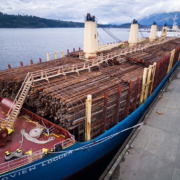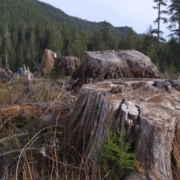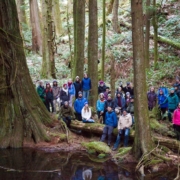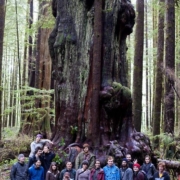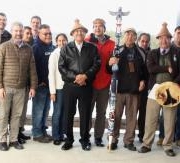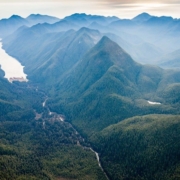Comment: Rising raw log exports bad for forests, workers
Events that have recently unfolded near the Crofton pulp mill underscore a troubling development on Vancouver Island, one that should deeply concern all Island residents who care about our shared forests and economy.
To the uninitiated, a massive parking lot beside one of the Island’s remaining pulp mills might be a bit of a head-scratcher. Until, that is, one sees all the raw logs being delivered by truck to the site and the ocean-going freighters waiting nearby.
TimberWest, one of British Columbia’s biggest log exporters, is behind the project. The new blacktop amounts to a massive new delivery area for logs, mainly from the Island. Logs delivered to the site will ultimately run through a machine known as a “debarker,” which strips away the outer layers, leaving logs that are smaller in diameter and primed to run through a sawmill.
Except those logs will never be run through sawmills in B.C., but rather in the United States or China or somewhere else far away.
“Debarking” is sadly what now passes for “value-added” — surely not what sustainable-forestry advocates had in mind after years of imploring the government to move our forestry industry up the value chain.
TimberWest’s shareholders know that under current rules, raw, unprocessed logs can be exported from the province in droves. And that is exactly what has happened with increasing regularity in recent years.
Since 2013, when the current provincial government was elected to a fourth consecutive term, nearly 26 million cubic metres of raw logs valued at more than $3 billion were shipped from B.C.
No provincial administration in B.C. history has presided over the exodus of so much raw natural capital and all the lost jobs it represents.
It is no accident that such exports are on the rise. In 2003, the government under then-premier Gordon Campbell scrapped important clauses that linked a company’s logging access in forests under provincial control to requirements to run logs through local mills.
Those rules — known as “appurtenancy” — were already frayed at the edges before the clauses were scrapped. But without them, sawmill closures skyrocketed and forest-industry employment plummeted.
In the past 10 years, forest companies have shed well over 22,000 jobs, or 27 per cent of their workforce. The largest job losses by far were in mills where men and women make solid-wood products.
At the same time, as revealed in new research by the Canadian Centre for Policy Alternatives, exports of raw, unprocessed logs have soared.
And for the first time, the majority of the exported logs are coming from public or Crown land (rather than private lands, as was the historic norm).
The nearly 6.3 million cubic metres exported from B.C. in 2016 is enough wood to build 134,000 houses, roughly half of Vancouver’s single-family housing stock. Using a conservative estimate, more than 3,600 B.C. workers could have been employed processing that wood.
The Coast Forest Products Association, which includes large B.C. forest companies such as TimberWest, Western Forest Products and Interfor, actively supports log exports, and its member companies account for nearly half the raw logs that have left B.C. in recent years.
The association says the profits earned from log exports make it possible for mill owners to keep operating the mills they have.
What it doesn’t say is that 100 B.C. sawmills have closed their doors in just 20 years. And it is silent on the most disquieting reality of all: Current rules likely mean further sawmill closures and even more log exports.
This is not a future British Columbians deserve.
That is why two forest industry unions (the Public and Private Workers of Canada and Unifor) and three environmental organizations (the Ancient Forest Alliance, Sierra Club B.C. and Wilderness Committee) are calling on the provincial government to implement a three-point plan to curb the exodus of raw logs and boost domestic manufacturing:
1. Place an immediate ban on all raw-log exports from old-growth forests.
2. Immediately impose progressively higher taxes on raw-log exports from second-growth forests to encourage new investments in domestic mills.
3. Introduce new policies to increase value-added manufacturing and jobs in rural and First Nation communities.
It’s beyond time that the provincial government ended years of policies that remove value from our forests. British Columbians need and want healthy forests and healthy, vibrant rural communities. Our research shows we can get there, and the time to do so is now.
Scott Doherty is executive assistant to Unifor national president Jerry Dias; Ben Parfitt is a resource policy analyst with the B.C. office of the Canadian Centre for Policy Alternatives, and has recently published new research on B.C. log exports available at policynote.ca; and Ken Wu is executive director of the Ancient Forest Alliance.

